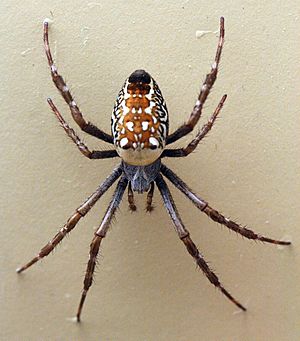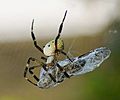Tent spider facts for kids
Quick facts for kids Tent spider |
|
|---|---|
 |
|
| Specimen in the Australian Museum | |
| Scientific classification | |
| Genus: |
Cyrtophora
|
| Species: |
moluccensis
|
| Synonyms | |
|
|
The tent spider, also known as the dome-web spider, is a type of spider called Cyrtophora moluccensis. It belongs to the orb-weaver family. These spiders are found in many places, including India, Japan, Indonesia, Papua New Guinea, Australia, Fiji, and Tonga.
You can often spot them in open areas or places where the land has been changed, from coastlines to forests and even mountains.
What Does It Look Like?
The tent spider has a unique look. Its body, called the abdomen, is quite tall. The front part of its body hangs over its head and chest area, known as the cephalothorax.
You can tell this spider apart from similar ones by two small bumps, called tubercles, on its abdomen. It also has a fancy pattern on its body. Female spiders have a special shape on a part called the median septum of the epigyne, which helps identify them.
Male spiders have a part called the embolus on their pedipalps. This part is hidden inside another part called the conductor. Young spiders and female spiders are usually yellow or green in color.
Amazing Webs
The webs built by Cyrtophora spiders are very different from typical orb-weaver webs. Most orb-weavers build flat, circular webs. But the tent spider builds a web that looks like a dome or a bowl. This is why it's sometimes called the "dome-web spider."
These webs are built horizontally, meaning they are flat like a table. Unlike other orb webs, the tent spider's web does not have sticky spirals. Instead, the non-sticky spiral parts are left as they are.
Scientists believe this special dome-shaped web developed from the usual flat orb web. These webs are very strong and can last for several weeks. This is great for the spider because it doesn't need to rebuild its web every single day, unlike many other spiders.
Spider Communities
Tent spiders can live alone, or they can live in groups called colonies. Even in a group, each spider protects its own web. These spider colonies can be quite large, covering an area of about fifteen square meters.
A single colony can have over four hundred spiders, including about fifty adult spiders. Young spiders often build their own small webs close to their parents' webs. Sometimes, other types of spiders, like Argyrodes miniaceus, or young spiders of different species, might live in the tent spider's web as guests.
Gallery





